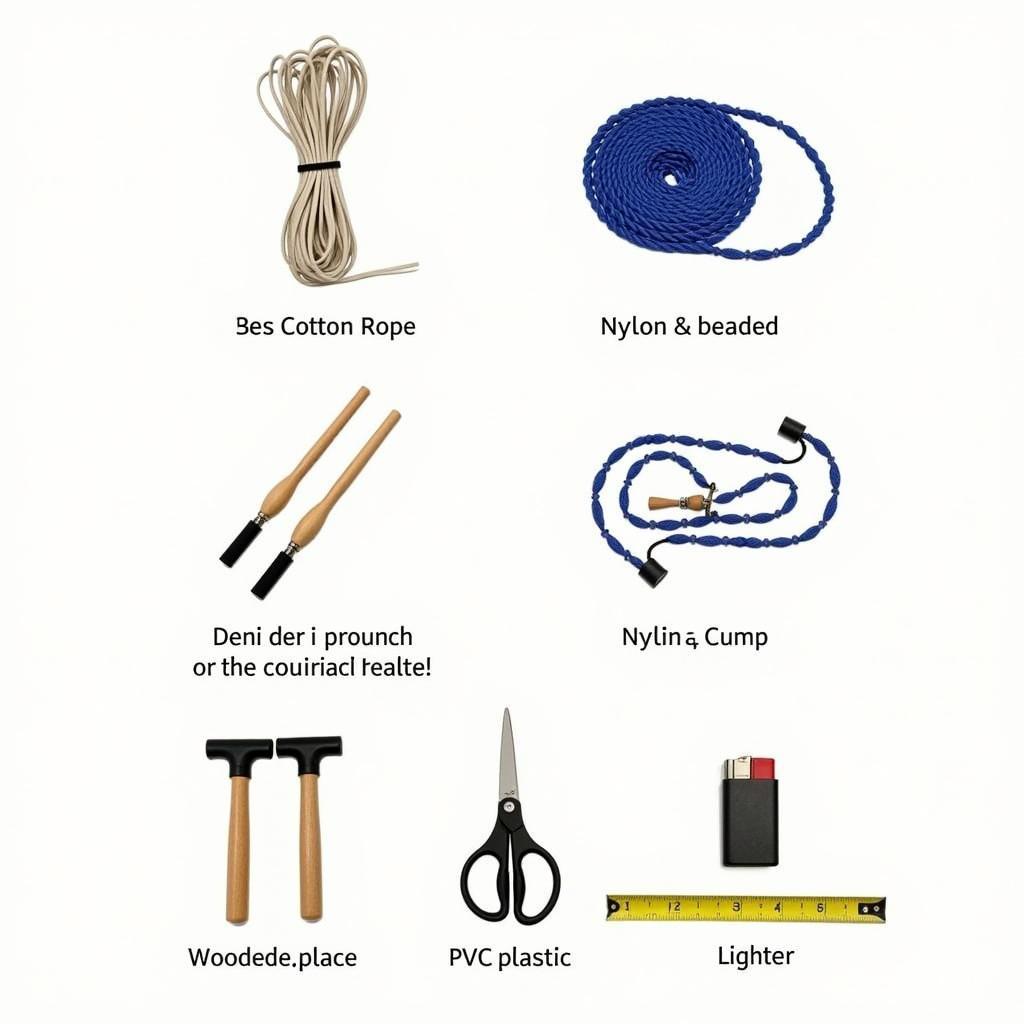Making Handmade Jump Ropes: A Comprehensive Guide
January 12, 2025Making a handmade jump rope might seem simple, but it can be a rewarding and surprisingly customizable activity. Whether you’re a fitness enthusiast looking for the perfect jump rope, a parent creating a fun activity for your kids, or simply looking for a new DIY project, this guide will provide you with all the necessary information.
 Essential supplies for crafting a jump rope
Essential supplies for crafting a jump rope
Choosing the Right Rope Material
The first step in making your handmade jump rope is selecting the right rope material. Several options cater to different preferences and needs. Cotton rope is a classic choice, offering a soft and comfortable grip. Nylon is a durable and lightweight alternative, ideal for speed jumping. Beaded ropes are another popular option, providing a satisfying rhythmic clicking sound and visual appeal during jumps. Each material has its own advantages and disadvantages in terms of durability, weight, and speed.
What type of rope offers the best grip? Many find cotton rope provides a comfortable, non-slip grip, especially for beginners.
What is the most durable rope material for jump ropes? Nylon tends to be the most durable material, resisting wear and tear from frequent use.
Selecting the Perfect Handles
The handles play a crucial role in comfort and control during your jump rope workouts. Wooden handles are a classic and eco-friendly option, offering a natural feel and a secure grip. Plastic handles are lightweight and come in various colors and designs. PVC pipes can be repurposed into affordable and durable handles, offering a customizable option. Comfort and grip are key considerations when choosing handles.
Which handles are best for beginners? Many beginners prefer lightweight plastic handles for their ease of use and comfortable grip.
Crafting Your Handmade Jump Rope: A Step-by-Step Guide
- Measure and Cut: Measure the desired length of your jump rope by standing on the middle of the rope and pulling the handles up to your armpits. Add a few extra inches for tying knots and attaching the handles. Cut the rope to this length.
- Prepare the Handles: If using PVC pipes, cut them to your desired handle length and sand down any rough edges. For pre-made handles, ensure they have a suitable method for attaching the rope.
- Attach the Rope to the Handles: Several methods exist for attaching the rope, including knotting, gluing, or using screws. Ensure the connection is secure and won’t come loose during use.
- Finishing Touches: If using nylon rope, carefully melt the ends with a lighter to prevent fraying. For beaded ropes, ensure the beads are securely fastened.
What’s the ideal length for a jump rope? The ideal length depends on your height. A good starting point is to stand on the middle of the rope and pull the handles to your armpits.
How do I prevent the rope from fraying? Melting the ends of nylon rope with a lighter is an effective way to prevent fraying.
Maintaining Your Handmade Jump Rope
Proper maintenance ensures your jump rope lasts. Store your jump rope in a cool, dry place away from direct sunlight. Avoid stepping or twisting the rope unnecessarily. Regular inspection for wear and tear is essential. Replace the rope or handles if necessary.
How do I store my jump rope? Store it in a cool, dry place to prevent damage.
Conclusion
Making a handmade jump rope is a fulfilling project that allows for customization and creativity. By carefully selecting the right materials and following the steps outlined, you can create a jump rope perfectly suited to your needs and preferences. So grab your materials and start crafting your perfect jump rope!
FAQ
- What type of rope is best for speed jumping? Nylon is often preferred for speed jumping due to its lightweight and aerodynamic properties.
- Can I use beads on any type of rope? Beads are most commonly used with nylon or plastic ropes.
- How often should I replace my jump rope? Replace it when you notice signs of wear and tear, such as fraying or broken handles.
- What are the benefits of making a handmade jump rope? Customization and the satisfaction of creating something yourself are key benefits.
- What’s the easiest type of handle to attach? Pre-made handles designed for jump ropes are often the easiest to attach.
- How can I adjust the length of my jump rope after it’s made? If using knots to attach the handles, you can adjust the knots. Otherwise, you may need to re-attach the handles.
- Are there any special tools needed for making a jump rope? Basic tools like scissors and a lighter (for nylon rope) are usually sufficient.
Common Jump Rope Questions
What are some common problems with jump ropes? Fraying ropes, loose handles, and incorrect length are common issues.
What are some alternatives to traditional jump rope handles? PVC pipes, dowels, and even knotted ends can serve as handles.
Further Resources
For more information on jump ropes and related topics, check out these resources:
Need help with your handmade jump rope project? Contact us!
Phone: 0396443476
Email: [email protected]
Address: 23 Tháng 3, Đắk Nia, Gia Nghĩa, Đắk Nông, Việt Nam.
We have a 24/7 customer service team ready to assist you.